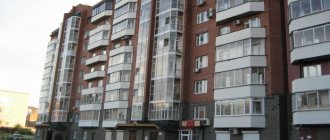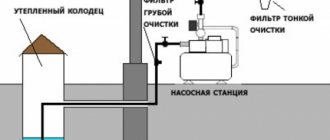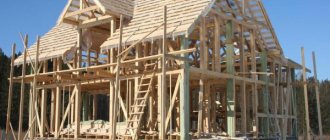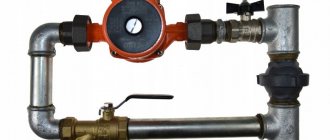A constant supply of hot water to a multi-apartment high-rise building can be carried out using two methods using different operating principles:
- In the first case, the hot water supply of an apartment building takes water from the cold water supply (cold water supply) pipeline, then the water is heated by an autonomous heat generator: an apartment boiler, a gas water heater or boiler, a heat exchanger that uses the heat of a local firehouse or thermal power plant;
- In the second case, the hot water supply scheme of an apartment building takes hot water directly from the heating main, and this principle is used in the residential sector much more often - in 90% of cases of organizing hot water supply in a residential building.
Important: the advantage of the second option of a water supply system for a residential building is better water quality, which is regulated by GOST R 51232-98. Also, when hot water is taken from a centralized heating main, the temperature and pressure of the liquid are quite stable and do not deviate from the specified parameters: the pressure in the pipeline of the hot water supply system is maintained at the level of the cold water supply, and the temperature is stabilized in the common heat generator.
Let us consider the water supply of an apartment building according to the second option in more detail, since this is the scheme that is most often used both in urban areas and in country houses, including country houses or garden houses.
What it is?
The term "hot water" is used often. According to SanPiN 2.1.4.2496-09, the standard is a temperature range of 60-75°. At the same time, water is considered cold if its temperature is below 40°.
These rules guide technicians and specialists, but it will also be useful for ordinary users to know the current standards.
The standards are drawn up in such a way as to ensure the basic requirements:
- destruction of harmful bacteria living in water;
- preventing burns.
Most types of microflora die already at 55°, but this requires at least 5-6 hours. If the water is heated to a minimum (60°), bacteria can withstand no more than 22 minutes, and at 66° they are destroyed in just 2 minutes.
Too hot water is dangerous even for adults , not to mention the elderly, sick people or children. Therefore, the upper limit is calculated so that the consequences of a burn are minimal.
At night (0.00-5.00 hours) a deviation from the standard limits of 5° is allowed. During the day, the permissible deviation limit is 3°.
Water supply for a residential building
The water supply system of a residential building is one of the main life support systems that are necessary to create normal living conditions. Therefore, the development of the project and installation of hot water and cold water systems must be carried out in strict compliance with current standards and SNiP. For integration, it is important to ensure professional design of the system and competent selection of the water supply scheme for an apartment building. Installation must be carried out by highly qualified performers using high quality components and materials.
Formula and its decoding
If hot water is supplied from the mains (this option is also called an open circuit), the calculation formula will be as follows: amount of hot water used (according to the meter) × domestic hot water tariff.
In MKD, another type of hot water preparation is often found . The house receives ordinary cold water, which is heated in a boiler installed in the basement (closed hot water supply circuit).
In such cases, another formula is used: the amount of hot water used (according to the meter) × cold water tariff plus the amount of thermal energy × heating tariff.
The second option for supplying hot water is becoming the main one, since it provides significant savings and reduces the cost of services.
Methods of obtaining and types of hot water supply
According to the method of production, DHW systems are divided into two types:
- open,
- closed.
Hot water supply for an apartment building comes in two versions:
- with single-pipe risers,
- with two-pipe risers.
The two-pipe system consists of two risers:
- server,
- circulation.
The heated water flows through the supply riser to the apartments, and through the circulation riser into the central main. Both pipelines are nearby. Heated towel rails are placed on the circulation riser in bathrooms - curved pipes that not only heat the rooms, but also compensate for temperature changes in the length of the pipe. The water in them will no longer be disassembled by consumers, but will be returned through the central pipeline back to the boiler room.
In a single-pipe scheme, each consumer has one riser - supply, and all circulation pipes are combined into one “idler”. It has no consumers, and the water through it returns to the main line.
Heated towel rails with this design:
- placed on the supply pipe,
- electric ones are installed,
- connect to the heating bed.
In the latter case, heated towel rails only operate during the heating season.
With any wiring scheme, the hot water supply system of an apartment building must be able to drain periodically occurring air pockets. With the top wiring, automatic relief valves are installed for such purposes; with the bottom, air can be removed through the top water intake valve.
Physical properties
The physical parameters of water depend on existing conditions . They are related to each other - a change in one value leads to a change in other values.
For convenience, we will compile a table of the physical parameters of hot water at standard temperatures (in the range from 60 to 75°):
| Options | Values at 60° | Values at 75° |
| State of aggregation | Liquid | Liquid |
| Density, ρ | 983.2 kg/m3 | 974.8 kg/m3 |
| Thermal conductivity, λ | 0.659 W/(m deg) | 0.671 W/(m deg) |
| Dynamic viscosity, μ | 469.9 Pa s | 381.8 Pa s |
| Kinematic viscosity, ν | 0.478 m2/s | 0.398 m2/s |
| Thermal expansion coefficient, β | 5.11 deg-1 | 6 deg-1 |
| Specific heat capacity, Cp | 4182 kJ/(kg deg) | 4191 kJ/(kg deg) |
| Surface tension coefficient, σ | 662.2 N/m | 635.4 N/m |
| Thermal diffusivity (x×108), a | 16 m2/s | 16.5 m2/s |
| Prandtl number | 2,93 | 2,38 |
Analyzing the data from this table, you can notice different dynamics of many parameters. Some increase with increasing temperature, others decrease.
For operating organizations working with hot water, these parameters help solve operational issues and keep the lines in good condition. This article will tell you which water has more weight - hot or cold.
Factors affecting boiler operation
They are:
- Design. The equipment may have 1 or 2 circuits. It can be mounted on a wall or on the floor.
- Normative and actual efficiency.
- Proper heating arrangement. The power of the equipment is comparable to the area that needs to be heated.
- Technical conditions of the boiler.
- Gas quality.
Question about the design.
The device may have 1 or 2 circuits. The first option is complemented by an indirect heating boiler. The second one already has everything you need. And the key mode in it is the provision of hot water. When water is supplied, heating ends.
Models mounted on the wall have less power than those placed on the floor. And they can heat a maximum of 300 sq.m. If your living space is larger, you will need a floor-mounted unit.
P.2 efficiency factors.
The document for each boiler reflects the standard parameter: 92-95%. For condensation modifications it is approximately 108%. But the actual parameter is usually 9-10% lower. It decreases even more due to heat losses. Their list:
- Physical underburning. The reason is excess air in the apparatus when gas is burned, and the temperature of the exhaust gases. The larger they are, the more modest the efficiency of the boiler.
- Chemical underburning. What is important here is the volume of CO2 oxide produced when carbon is burned. Heat is lost through the walls of the apparatus.
Methods for increasing the actual efficiency of a boiler:
- Removing soot from pipelines.
- Elimination of scale from the water circuit.
- Limit chimney draft.
- Adjust the position of the blower door so that the coolant reaches its maximum temperature.
- Removing soot from the combustion compartment.
- Installation of a coaxial chimney.
P.3 Questions about heating. As already noted, the power of the device necessarily correlates with the heating area. A competent calculation is needed. The specifics of the structure and potential heat losses are taken into account. It is better to entrust the calculation to a professional.
If the house is built according to building codes, the formula works: 100 W per 1 sq.m. This results in a table like this:
| Area (sq.m.) | Power. | ||
| Minimum | Maximum | Minimum | Maximum |
| 60 | 200 | 25 | |
| 200 | 300 | 25 | 35 |
| 300 | 600 | 35 | 60 |
| 600 | 1200 | 60 | 100 |
It is better to purchase foreign-made boilers. Also in advanced versions there are many useful options that help you achieve the optimal mode. One way or another, the optimal power of the device is in the spectrum of 70-75% of the highest value.
The optimal operating mode of a gas boiler to save gas is achieved by eliminating clocking. That is, you need to set the gas supply to the lowest value. The attached instructions will help with this.
What is its color, how is it displayed in plumbing?
Externally, hot water is no different from cold water . However, it is necessary to separate pipelines with different flows in drawings and diagrams to avoid confusion.
Pipelines with water according to GOST are indicated in green. This is a general marking that can be applied either as a solid color or using transverse rings located in conspicuous places.
On plumbing fixtures, control valves are painted differently . The usual designations are blue (cold) and red (hot water).
This is due to the psychological perception of temperature. Blue is the color of ice, and red is the color of hot metal, fire. Read about hot water pipes here. You can find out which side the hot water is on the mixer here.
Coordination of coolant and boiler temperatures
Regulators help coordinate the temperature of the coolant and the boiler.
These are devices that create automatic control and adjustment of return and supply temperatures. The return temperature depends on the amount of liquid passing through it. Regulators cover the liquid supply and increase the difference between the return and supply to the level required, and the necessary indicators are installed on the sensor.
If the flow needs to be increased, a boost pump can be added to the network, which is controlled by a regulator. To reduce the heating of the supply, a “cold start” is used: that part of the liquid that has passed through the network is again transported from the return to the inlet.
The regulator redistributes the supply and return flows according to the data collected by the sensor, and ensures strict temperature standards for the heating network.
Quality requirements
Hot water must comply with sanitary standards defined in GOST 2874-82 and SanPin 2.1.4.2496-09. The main requirement is to ensure temperature limits of 60-75°, where the minimum value is due to the need to comply with epidemiological safety standards, and the maximum allows to avoid severe burns.
One of the most common and dangerous infectious agents is legionella, which lives in water. DHW networks are a potential source of infection, so control of water temperature must be strict and constant.
In addition, the amount of foreign components - solid particles and suspended matter - is standardized. Their amount should not exceed 5 mg/m3. pH, the degree of acidity, is no less strictly regulated. According to the standards, the level should be between 6-9. The water should be clear and odorless.
This and this article will tell you about the temperature of hot water in the tap. You can find out how to measure your temperature here.
In MKD
DHW is supplied to the apartment building according to the usual sanitary and technical standards . There are no exceptions or special conditions.
All requirements are valid for any residential buildings. The main problem with DHW supply in apartment buildings is the simultaneous use of one riser by many subscribers.
The water has time to cool while it passes through a long open pipeline . For users who are connected to the end points of the riser, ensuring the standard water temperature becomes a serious task, which is solved by insulating pipelines and increasing the initial temperature to the permitted maximum. Read more here.
In public institutions
The quality of hot water in institutions is determined by general standards and is ensured by the same methods as in residential buildings.
There is no difference, since the end consumers are people in any case. The standards for temperature, composition and the presence of foreign elements must be fully observed.
Since DHW is supplied through the same lines (or using the same equipment), it is not difficult to obtain the expected result.
Features of water supply to multi-apartment buildings
It is very difficult to establish water supply for a multi-storey building with numerous consumers. Each apartment in the house should be considered as a separate object for providing water: pipes of various diameters form a single structure with rather complex wiring. It is for this reason that water supply to a multi-storey building is considered very difficult.
The system is a whole complex of pumping equipment with installed filters and metering devices, as well as shut-off and control valves and apartment-by-apartment pipe distribution.
Pressure regulators will be mandatory in this scheme. The water that enters the apartments first goes through several stages of purification to remove mechanical impurities. Water is also often disinfected using chlorination.
Central water supply and water supply system
The most convenient way for people who live in apartment buildings is to supply water from a central water supply. This system involves supplying high-quality water under good pressure. Central water supply is carried out through a water supply system, which is available in all cities and villages. As a rule, water enters pumping stations from surface reservoirs that are located far from sources of pollution.
The central water supply system has three components:
- water intake structures;
- cleaning stations;
- distribution network.
Water flows from the pumping station into a specific reservoir. There it goes through numerous stages of purification and only then enters the distribution network to supply water to the necessary facilities.
The water supply system functions normally if the pipes are laid out in a high-quality and correct manner. System pressure also plays a big role.
For a large number of users, the central water supply system may have a well, which is arranged using a special water intake tower. It is best to use an artesian well: water is drawn from great depths, the quality of the water is high.
But this method of collecting water is considered quite expensive. It is usually used to provide water to an apartment cottage.
Diagram and design of the water supply system of an apartment building
Water supply system with water tower
Such a system has several main elements: a caisson, a main tank for water intake and a pumping station.
Working principle of a water tower
A caisson is a metal container located at a depth of 2-2.5 m above the well itself. A pipe is installed in it to drain water from the well. A concrete ring caisson is considered less airtight, since very often it is flooded by incoming groundwater.
Through the pumping station and the caisson, water enters the storage tank. It is equipped with an automatic float valve. It turns on the pump when the water in such a container drops and does not reach a certain level.
The total pressure in the system directly depends on the volume of the storage tank or tank. Even in the event of a power outage, water will flow into the apartments consistently. But until the water level in the tank drops and, accordingly, the pressure decreases.
Water tower design diagram
Types of pipes used for water supply
Steel pipes
Today, steel pipes have practically ceased to be used. Over a fairly long period of time, such materials for plumbing have used up their resources. In addition, the price of steel pipes is quite high.
Installation of steel pipes is also expensive and takes a lot of effort and time. The disadvantage of such a system is that condensate accumulates heavily on it, which can destroy the pipe material. Rust and plaque will gradually form inside the steel pipe, which reduces the volume of the pipe. Thus, throughput is also reduced.
Copper pipes
The most important advantage of using copper pipes is their service life, which reaches 50 years. Steel pipes are quite expensive, and not everyone can afford them. The advantage of steel pipes is that rust does not form on them. In addition, copper has bactericidal properties.
Copper pipe wiring
Metal-plastic pipes
Metal-plastic pipes are extremely popular today. They are quite practical and considered reliable. Installation of metal-plastic water supply is very simple. All you need is a special tool. The pipes are joined using fittings. The pipe can withstand significant mechanical and physical loads.
Metal-plastic pipes
Connection diagrams
DHW supply is carried out in different ways , depending on the specifics of the premises, their purpose and design features. Let's look at the most common connection diagrams.
In the apartment
Hot water is supplied to the apartment through a common riser.
To connect a subscriber, it is necessary to make a horizontal outlet (bed) equipped with shut-off valves (usually a ball valve) with the necessary instruments and devices - a meter, a filter, a check valve, etc.
A horizontal pipeline is placed along the plumbing installation line; all sinks, toilets, and bathtubs are connected to it. As a rule, there is only one sunbed per apartment, although any options are possible.
Read about moving a hot water riser here, and about replacing it here.
In a private house
DHW supply to a private house can be done in two ways:
- Centralized water supply . A pipeline with hot water is installed in the house and shut-off valves are installed. Further wiring is carried out in the usual way - a sunbed is installed, to which all the necessary plumbing and household appliances are connected.
- Autonomous water supply . Here the source of hot water is a boiler or indirect heating boiler. They are connected to horizontal wiring, assembled according to the usual scheme.
Both options have their pros and cons. Today, the autonomous method of supplying hot water is beginning to prevail.
In the bath
DHW is heated in a bathhouse, as a rule, using its own heat exchanger. An exception may be old public baths, where hot water is still supplied through an open system.
To heat water, use a sauna stove, an indirect heating boiler or a gas heater. The choice depends on the size of the bathhouse, the needs of people and the type of available sources of thermal energy.
Read more here.
Heated towel rail
Heated towel rails are connected to the hot water riser only in houses with a combined bathroom.
The device is connected to the pipeline at two points (flow inlet and outlet) without interrupting its movement.
The passage of water is directly provided by a bypass, which is prohibited from being blocked or even equipped with shut-off valves.
Connecting a heated towel rail to a hot water riser ensures constant operation of the device, independence from seasonal heating shutdowns. However, the installation must be carried out correctly and without errors, otherwise the supply of hot water to other subscribers will be disrupted. You can find out more here.
Breakdowns in the hot or cold water distribution system
You can fix the following emergency situations with your own hands:
The valve or faucet is leaking. This happens most often due to wear of the oil seal or seal. To eliminate the malfunction, it is necessary to open the valve completely and with force so that the raised oil seal stops the leak. This technique will help for a while; in the future, the valve must be rebuilt and worn parts replaced.
Noise and vibration of a valve or faucet when opening in a hot water supply system (less often cold). The cause of noise is most often wear, deformation or crushing of the gasket in the gearbox of the mechanism. Noises appear if the tap is not opened all the way. This fault can cause a series of water hammers in the pipes, so its elimination is of utmost importance. The faucet valve is capable of closing the valve seat in the faucet or valve body in a few milliseconds, if it is not a ball valve, but a screw valve. Why is the risk of water hammer higher in hot water supply systems? Because in hot water pipes the operating pressure is higher.
How to fix the problem:
- Shut off the water at the inlet;
- Unscrew the valve housing of the noisy faucet;
- Replace the gasket, but before installing, chamfer the new gasket so that the valve does not vibrate when opening under high pressure.
The heated towel rail does not heat up. The cause of the breakdown may be the presence of air in the water supply system with constant coolant circulation. Typically, air accumulates in a pipe jumper, which is installed between adjacent risers, after an emergency or scheduled drain of water. The problem is eliminated by bleeding the air plugs. To do this you need:
- Vent the air at the highest point of the system - on the top floor;
- Shut off the hot water supply riser located in the apartment (the riser is closed in the basement of the house);
- Open all hot water taps in the apartment;
- After bleeding air through taps and mixers, you need to close them. And open the shut-off valve on the riser.
Why is circulation needed?
If the hot water is stationary in the pipe, it will quickly cool down and no longer meet regulatory requirements.
Therefore, to ensure the required quality, water is circulated - it constantly moves in a circle, leaving the boiler, passing through the riser and returning back to be heated.
Dead-end DHW supply schemes are ineffective and are gradually disappearing, giving way to more advanced and economical options.
This article will tell you what circulation of hot water is; this article will tell you about recirculation.
Dismantling sewerage in an apartment
Replacing an old sewer pipe with a new one has many nuances that must be taken into account in this process. Initially, it is necessary to determine the places in the pipe that are most vulnerable to deformation. You also need to disconnect all existing connections from the pipe and remove all debris. All this is needed to ensure more convenient work.
Then, near the riser, the tap is turned off, which supplies water to the apartment. If the replacement will take a long time, then it is best to completely disconnect the entire riser from the water supply. At the very last moment, it is necessary to carefully dismantle the cast iron sewer pipes. All this can be done using adjustable wrenches or other tools.
It is necessary to install a new pipe in a complete set with various adapters and couplings, since then it will not be possible to do it efficiently. All connections must be sealed with sealant to protect the riser from leaking.
What is GW admixture?
The addition of hot water occurs in faulty mixers or distribution units , where there is a simultaneous connection of hot water and hot water pipelines.
If the pressure of hot water exceeds that of cold water, the water begins to gradually squeeze out the cold flow and fill the cold water pipeline. The opposite situation also occurs, when hot water is replaced by cold water.
The only way to deal with these problems is to identify the problem unit and repair it or replace it with a better model. More details can be found here.
Thermal energy component
It is impossible to find out the amount of heat energy spent using a measuring device. During its calculation, the following data is taken into account:
- tariff applied to DHW;
- calculation of heat loss;
- funds spent on maintaining the trunk system;
- transportation costs.
The service is usually calculated taking into account the current readings of the general house flow meter. In addition, the energy of the heated water is taken into account. This indicator is calculated individually for each apartment.
How does it appear on the receipt?
The usual “hot water” column in housing and communal services receipts is practically no longer found . Let's consider options for designating services in modern conditions.
Recording options and their decoding
The easiest way to decipher the line “DHW”, “amount of hot water” or similar designations. This refers to the volume of hot water used during the reporting period.
As a rule, this designation is used on open hot water supply systems, which are still in operation in some localities.
There is another designation option . The DHW meter reading (or standard value) is taken into account, but the cost is calculated as the sum of the cost of the amount of cold water determined by the meter and its heating.
The water is designated as “cold water for DHW”, or “DHW: coolant component”. Thermal energy is designated “DHW: component on TE (thermal energy)”. Read more here.
Heating
Heating hot water is the procedure of heating ordinary cold water to the standard value. It is produced in a boiler located directly in the basement of the MKD .
This method provides significant savings and reduces the cost of hot water. Read more here.
How to convert gcal to m3?
To heat 1 m3 of water, a certain amount of thermal energy is spent.
1 Gcal is the amount of heat required to heat 1000 tons of water. A ton is 1 m3. Therefore, to heat 1 m3 of water by 1 degree it takes 0.001 Gcal.
Based on this ratio, you can calculate the amount of heat required to heat a certain amount of water to a given temperature. Read more here.
Bottlings
Water supply bottlings are horizontal pipes running through the basement and connecting the risers with the elevator and water metering units. The filling diameter, depending on the material and volume of water consumers, ranges from 32 to 100 mm.
A water supply project for an apartment building must take into account not only the current condition of the pipelines, but also their inevitable overgrowth with sediment and rust after 20-25 years of operation. There are two dispensers in the hot water circulation system.
For internal hot water pipelines, SNiP 2.04.01-85 recommends the use of plastic pipes and fittings. Fittings are used from:
- polyethylene,
- polypropylene,
- polyvinyl chloride,
- metal-polymer,
- fiberglass,
- other plastic materials for water supply networks.
To avoid corrosion, the systems are made of galvanized pipes.
For all internal water supply networks of an apartment building, you can use:
- copper pipes,
- shaped parts,
- bronze pipes,
- with protective coating against rust,
- brass pipes.
With pipe diameters of more than 150 mm in open heat supply systems, black pipes can be used. Thermal insulation of these elements is mandatory for hidden wiring and in unheated rooms. You can use foamed polyethylene, it will make a so-called “fur coat”.
Where to go if there is no hot water supply?
As a rule, home owners enter into an agreement for the supply of hot water with a management company. Less often, contracts are concluded directly with resource suppliers.
The reasons for the lack of hot water supply can be different : from a serious accident on the line to planned repair work.
If there is no hot water for too long, you need to contact the organization with which the contract has been drawn up. All necessary information can also be obtained from the management company or from the management of the HOA.
You can find out where to complain if there is no hot water here, where to call - here.
Adjustment
Automatic control is provided by the heating regulator.
It includes the following parts:
- Computing and matching panel.
- Actuating device on the water supply section.
- An actuator that performs the function of mixing liquid from the returned liquid (return).
- Boost pump and sensor on the water supply line.
- Three sensors (on the return line, on the street, inside the building). There may be several of them in the room.
The regulator closes the liquid supply, thereby increasing the value between return and supply to the value specified by the sensors.
To increase the flow, there is a boost pump and a corresponding command from the regulator. The incoming flow is controlled by a "cold bypass". That is, the temperature decreases. Some of the liquid that has circulated along the circuit is sent to the supply.
Sensors collect information and transmit it to control units, resulting in a redistribution of flows that provide a rigid temperature scheme for the heating system.
Sometimes, a computing device is used that combines hot water and heating regulators.
The hot water regulator has a simpler control scheme. The hot water sensor regulates the flow of water with a stable value of 50°C.
Advantages of the regulator:
- The temperature scheme is strictly maintained.
- Elimination of overheating of the liquid.
- Fuel and energy efficiency.
- The consumer, regardless of the distance, receives heat equally.
What if the wrong water flows from the tap?
Let's consider common situations:
Cold instead of hot
Sometimes the water simply cools down in the pipes, and you just need to let it through a little so that the temperature rises to the standard level.
But a prolonged lack of hot water may be the result of a broken boiler. In such cases, the HOA or management company must be notified. Read more here.
Hot instead of cold
If hot water comes out of a cold tap, there are 2 possible reasons:
- the water supply is incorrectly connected (flexible hoses are mixed up);
- Hot water is mixed into a cold pipe.
In the first case, you need to swap the hoses. The second situation is somewhat more complicated - you need to identify the problematic faucet or plumbing fixture and repair (replace) it. Otherwise, you will have to put up with the inconveniences that arise.
Another possible reason is that the management company’s workers accidentally mixed up the pipelines during repairs and redirected the cold and hot flows. You need to find out from the neighbors above (below) if they have the same problem, and contact the Criminal Code. Read more in this article.
Elements
Is a water metering unit a piping unit for a water supply network? consisting of shut-off valves, measuring instruments and fittings. The elevator unit is an element of the heating system that allows you to reduce the temperature of the coolant supplied from the thermal power plant to the set level.
The heating elevator mixes high-temperature coolant from the thermal power plant and cooled coolant from the return heating line of an apartment building.
Problems with DHW
Any problems with the hot water supply may mean either a malfunction of the apartment plumbing, or a breakdown of equipment on the line in the basement.
You need to know that scheduled hot water outages cannot take more than 8 hours a month or 4 hours in a row .
However, if there is an accident on the line, you will have to wait until it is fixed. Longer breaks are also possible here, since restoring the operation of the main line is a complex and time-consuming task.
You can find out about problems associated with weak hot water pressure here. This article will tell you how to recalculate hot water. You can find out more about hot water pumps here.
Malfunctions
Main malfunctions of the water supply system valve:
- when closed, it allows water to pass through,
- liquid flows through the rod,
- presence of leakage through threaded connections.
The causes of malfunctions are wear of the rubber valve gasket, seat shell, worn rod threads, worn out stuffing box, weak seal of threaded connections.
If a mixer with a ceramic axle box begins to make noise, then the cause is a sagging silicone washer. It is best to replace the ceramic valve axle with the same new one or an analogue.
Lever mixers make virtually no noise, but if this does happen, the only solution is to normalize the pressure in the system. To do this, reducers are installed in front of the mixer, which limit the pressure, then the noise stops. A similar approach can be used to eliminate noise in a hygienic shower mixer.
The video shows how to correctly calculate the cost of hot water.
Resource saving
Saving hot water is possible in most cases . For example, when washing dishes or brushing your teeth, water goes down the drain aimlessly.
If you close it and use only a certain amount in a sink with a stopper, you can make significant savings. This also applies to other procedures - for example, you can take a bath less often, limiting yourself to a shower.
You will find the standard for hot water consumption in this material. Read about connecting a washing machine to the hot water supply here.
Table with temperature graph
The operating mode of boilers depends on the environmental weather.
If we take various objects, for example, a factory building, a multi-storey building and a private house, they will all have an individual thermal diagram.
In the table we show the temperature diagram of the dependence of residential buildings on outside air:
| Outdoor temperature | Temperature of network water in the supply pipeline | Return water temperature |
| +10 | 70 | 55 |
| +9 | 70 | 54 |
| +8 | 70 | 53 |
| +7 | 70 | 52 |
| +6 | 70 | 51 |
| +5 | 70 | 50 |
| +4 | 70 | 49 |
| +3 | 70 | 48 |
| +2 | 70 | 47 |
| +1 | 70 | 46 |
| 70 | 45 | |
| -1 | 72 | 46 |
| -2 | 74 | 47 |
| -3 | 76 | 48 |
| -4 | 79 | 49 |
| -5 | 81 | 50 |
| -6 | 84 | 51 |
| -7 | 86 | 52 |
| -8 | 89 | 53 |
| -9 | 91 | 54 |
| -10 | 93 | 55 |
| -11 | 96 | 56 |
| -12 | 98 | 57 |
| -13 | 100 | 58 |
| -14 | 103 | 59 |
| -15 | 105 | 60 |
| -16 | 107 | 61 |
| -17 | 110 | 62 |
| -18 | 112 | 63 |
| -19 | 114 | 64 |
| -20 | 116 | 65 |
| -21 | 119 | 66 |
| -22 | 121 | 66 |
| -23 | 123 | 67 |
| -24 | 126 | 68 |
| -25 | 128 | 69 |
| -26 | 130 | 70 |
There are certain standards that must be observed in the creation of projects for heating networks and the transportation of hot water to the consumer, where the supply of water steam must be carried out at 400°C, at a pressure of 6.3 Bar. It is recommended that the heat supply from the source be released to the consumer with values of 90/70 °C or 115/70 °C.
Regulatory requirements must be met in compliance with the approved documentation with mandatory approval from the Ministry of Construction of the country.
Link to download the chart
- 110 - for industrial premises of categories B, D and D with emissions of flammable dust and aerosols;
- 130 - for industrial premises without the release of flammable dust and aerosols.
The maximum temperature, °C, of the heating surface should be taken as follows:
- c) for low-temperature panels for radiant heating of workplaces - 60.
- d) for high-temperature radiant heating devices - 250.
- e) for building structures with built-in heating elements:
- — 26 — for floors of rooms with constant occupancy;
- — 30 — for bypass paths, benches of swimming pools;
- — 31 — for floors of premises with temporary occupancy;
- - 28, 30, 33, 36, 38 for ceilings with a room height not exceeding 2.8, 3.0, 3.5, 4 and 6 m, respectively.
Cooler temperature
The cooler design has two water temperature sensors . One is adjusted to a temperature of 68-85°, and the second - to 90-98°. This value should be considered the operating maximum for most coolers.
It should be borne in mind that over time, device heaters somewhat reduce their capabilities, which is why the maximum temperature may decrease by several degrees.
Read more here.
Use
Today, many online publications promote the use of hot water as an effective means for removing toxins and cleansing the body.
It is claimed that hot water can remove excess fat , women can get rid of menstrual cramps, etc. The effectiveness of this technique has not yet been proven, as well as the possible harm from it.
Let's take a closer look at some aspects of this issue:
Can you drink from the tap?
Drinking tap water is not recommended . Especially if it's hot water. Some experts consider it technical, since it is heated in specialized equipment.
However, the preparation, purification and disinfection of tap water is carried out regardless of its further use. However, it is recommended to boil the water before drinking without drinking tap water. Details are in this article.
The benefits and harms of regular drinking
It is believed that hot water stimulates the functioning of all glands and systems of the body, tones the muscular system and stimulates metabolism. However, no one has yet provided indisputable evidence of these possibilities of hot water.
At the same time, uncontrolled consumption is harmful to the cardiovascular system, as this increases blood volume and pressure and increases the load on the heart. Therefore, careless adherence to fashion can cause significant harm.
People with problems of the cardiovascular system are advised to limit their consumption . Is it healthy to drink hot water? You can find out here.
When losing weight
Drinking hot water when losing weight is due to its ability to relieve spasms of the gastrointestinal tract and temporarily remove the feeling of hunger. The less often a person eats, the less likely he is to become overweight.
The technique is simple and does not require you to limit yourself to delicious foods. It’s just that eating becomes less frequent, which has a positive effect. Read more here.
With lemon
Many users know about the benefits of drinking a glass of hot water with a few drops of lemon in the morning on an empty stomach . There are also more radical methods that require drinking hot water with lemon before each meal.
Lemon is a source of vitamins necessary for humans. However, for people suffering from peptic ulcers, high acidity of the stomach, or other gastrointestinal problems, drinking hot water with lemon can cause significant harm. This article will tell you in more detail about the benefits and harms of hot water with lemon.
Protection against low coolant temperature in the return of a solid fuel boiler.
What will happen to a solid fuel boiler if its return temperature is below 50 °C? The answer is simple - a tarry coating will appear on the entire surface of the heat exchanger. This phenomenon will reduce the performance of your boiler, make it much more difficult to clean, and most importantly, can lead to chemical damage to the walls of the boiler heat exchanger. To prevent such a problem, it is necessary to provide appropriate equipment when installing a heating system with a solid fuel boiler.
The task is to ensure the temperature of the coolant that returns to the boiler from the heating system at a level not lower than 50 °C. It is at this temperature that the water vapor contained in the flue gases of a solid fuel boiler begins to condense on the walls of the heat exchanger (transition from a gaseous state to a liquid one). The transition temperature is called the “dew point”. The condensation temperature directly depends on the moisture content of the fuel and the amount of hydrogen and sulfur formations in the combustion products. As a result of a chemical reaction, iron sulfate is obtained - a substance useful in many industries, but not in a solid fuel boiler. Therefore, it is quite natural that manufacturers of many solid fuel boilers remove the boiler from warranty if there is no return water heating system. After all, here we are not dealing with the burning of metal at high temperatures, but with chemical reactions that no boiler steel can withstand.
The simplest solution to the problem of low return temperature is to use a thermal three-way valve (anti-condensation thermostatic mixing valve). The thermal anti-condensation valve is a thermomechanical three-way valve that ensures the admixture of coolant between the primary (boiler) circuit and the coolant from the heating system in order to achieve a fixed boiler water temperature. In essence, the valve releases the coolant that has not yet been heated in a small circle and the boiler heats itself. After reaching the set temperature, the valve automatically opens the coolant to the heating system and operates until the return temperature again drops below the set values.
Solid fuel boiler piping - Anti-condensation valve
Is it possible to swim in it?
Some argue that hot water can increase blood pressure and create a threat of strokes, heart attacks and other undesirable consequences. Others note a relaxing and tonic effect, the ability to relieve stress, and relieve negative emotions. Most likely, both are right.
Only people in good health who do not have problems with the cardiovascular system can swim in hot water. Others should limit the bath temperature to 40°.
This article will tell you more.
Optimal values in an individual heating system
Autonomous heating helps to avoid many problems that arise with a centralized network, and the optimal temperature of the coolant can be adjusted according to the season.
In the case of individual heating, the concept of standards includes the heat transfer of a heating device per unit area of the room where this device is located. The thermal regime in this situation is ensured by the design features of the heating devices. It is important to ensure that the coolant in the network does not cool below 70 °C. 80 °C is considered optimal
With a gas boiler, it is easier to control heating, because manufacturers limit the ability to heat the coolant to 90 °C. Using sensors to regulate the gas supply, the heating of the coolant can be adjusted.
It is a little more difficult with solid fuel devices; they do not regulate the heating of the liquid, and can easily turn it into steam. And it is impossible to reduce the heat from coal or wood by turning the knob in such a situation. Control of heating of the coolant is quite conditional with high errors and is carried out by rotary thermostats and mechanical dampers.
Electric boilers allow you to smoothly regulate the heating of the coolant from 30 to 90 °C. They are equipped with an excellent overheat protection system.
Defrosting meat
There is an opinion that meat should be defrosted in ice water . The main arguments of the supporters of this method concern the properties of the protein to fold at temperatures above 40°.
However, modern research has shown that defrosting meat in water at a temperature of 60° is quite possible.
Control pieces of meat were thawed in different ways, after which they were cooked and carried out a “blind” test. Its results were unexpected - the tasters could not determine which meat was defrosted in hot water and which in cold water. You can find out more here.
What to do if you get burned?
Hot water burns most often occur in the kitchen . In second place are baths and saunas. There are usually no remedies for burns on hand, but they are not immediately required. First of all, you need to relieve the pain, which is best done under running cold water.
If the burn is not too severe, 5 minutes is enough. After this, the burned area should be lubricated with Vaseline or aloe vera gel.
If bubbles appear, do not puncture them. If the pain is very bothersome, you can take ibuprofen or another analgesic.
Read more here and here.











